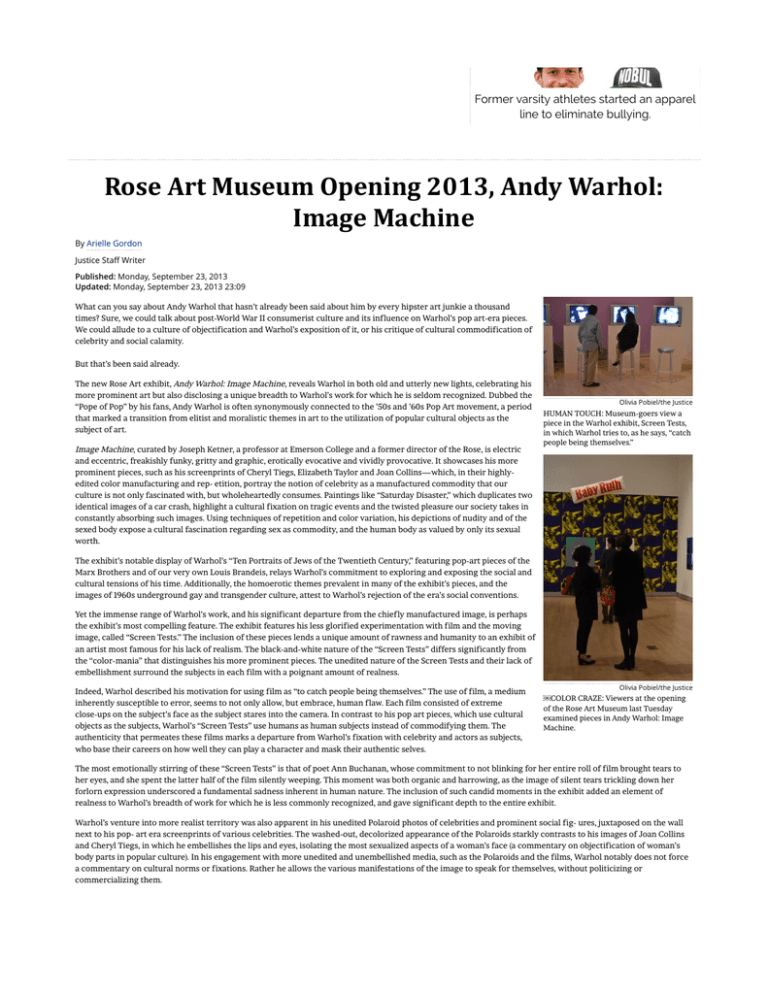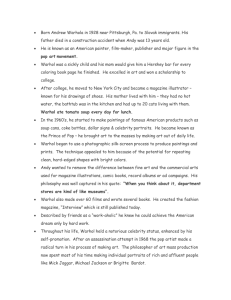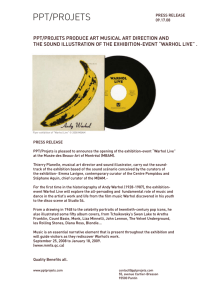Document 14406833
advertisement

Former varsity athletes started an apparel line to eliminate bullying. Rose Art Museum Opening 2013, Andy Warhol: Image Machine By Arielle Gordon Justice Staff Writer Published: Monday, September 23, 2013 Updated: Monday, September 23, 2013 23:09 What can you say about Andy Warhol that hasn’t already been said about him by every hipster art junkie a thousand times? Sure, we could talk about post-World War II consumerist culture and its influence on Warhol’s pop art-era pieces. We could allude to a culture of objectification and Warhol’s exposition of it, or his critique of cultural commodification of celebrity and social calamity. But that’s been said already. The new Rose Art exhibit, Andy Warhol: Image Machine, reveals Warhol in both old and utterly new lights, celebrating his more prominent art but also disclosing a unique breadth to Warhol’s work for which he is seldom recognized. Dubbed the “Pope of Pop” by his fans, Andy Warhol is often synonymously connected to the ’50s and ’60s Pop Art movement, a period that marked a transition from elitist and moralistic themes in art to the utilization of popular cultural objects as the subject of art. Image Machine, curated by Joseph Ketner, a professor at Emerson College and a former director of the Rose, is electric and eccentric, freakishly funky, gritty and graphic, erotically evocative and vividly provocative. It showcases his more prominent pieces, such as his screenprints of Cheryl Tiegs, Elizabeth Taylor and Joan Collins—which, in their highlyedited color manufacturing and rep- etition, portray the notion of celebrity as a manufactured commodity that our culture is not only fascinated with, but wholeheartedly consumes. Paintings like “Saturday Disaster,” which duplicates two identical images of a car crash, highlight a cultural fixation on tragic events and the twisted pleasure our society takes in constantly absorbing such images. Using techniques of repetition and color variation, his depictions of nudity and of the sexed body expose a cultural fascination regarding sex as commodity, and the human body as valued by only its sexual worth. Olivia Pobiel/the Justice HUMAN TOUCH: Museum-goers view a piece in the Warhol exhibit, Screen Tests, in which Warhol tries to, as he says, “catch people being themselves.” The exhibit’s notable display of Warhol’s “Ten Portraits of Jews of the Twentieth Century,” featuring pop-art pieces of the Marx Brothers and of our very own Louis Brandeis, relays Warhol’s commitment to exploring and exposing the social and cultural tensions of his time. Additionally, the homoerotic themes prevalent in many of the exhibit’s pieces, and the images of 1960s underground gay and transgender culture, attest to Warhol’s rejection of the era’s social conventions. Yet the immense range of Warhol’s work, and his significant departure from the chiefly manufactured image, is perhaps the exhibit’s most compelling feature. The exhibit features his less glorified experimentation with film and the moving image, called “Screen Tests.” The inclusion of these pieces lends a unique amount of rawness and humanity to an exhibit of an artist most famous for his lack of realism. The black-and-white nature of the “Screen Tests” differs significantly from the “color-mania” that distinguishes his more prominent pieces. The unedited nature of the Screen Tests and their lack of embellishment surround the subjects in each film with a poignant amount of realness. Indeed, Warhol described his motivation for using film as “to catch people being themselves.” The use of film, a medium inherently susceptible to error, seems to not only allow, but embrace, human flaw. Each film consisted of extreme close-ups on the subject’s face as the subject stares into the camera. In contrast to his pop art pieces, which use cultural objects as the subjects, Warhol’s “Screen Tests” use humans as human subjects instead of commodifying them. The authenticity that permeates these films marks a departure from Warhol’s fixation with celebrity and actors as subjects, who base their careers on how well they can play a character and mask their authentic selves. Olivia Pobiel/the Justice COLOR CRAZE: Viewers at the opening of the Rose Art Museum last Tuesday examined pieces in Andy Warhol: Image Machine. The most emotionally stirring of these “Screen Tests” is that of poet Ann Buchanan, whose commitment to not blinking for her entire roll of film brought tears to her eyes, and she spent the latter half of the film silently weeping. This moment was both organic and harrowing, as the image of silent tears trickling down her forlorn expression underscored a fundamental sadness inherent in human nature. The inclusion of such candid moments in the exhibit added an element of realness to Warhol’s breadth of work for which he is less commonly recognized, and gave significant depth to the entire exhibit. Warhol’s venture into more realist territory was also apparent in his unedited Polaroid photos of celebrities and prominent social fig- ures, juxtaposed on the wall next to his pop- art era screenprints of various celebrities. The washed-out, decolorized appearance of the Polaroids starkly contrasts to his images of Joan Collins and Cheryl Tiegs, in which he embellishes the lips and eyes, isolating the most sexualized aspects of a woman’s face (a commentary on objectification of woman’s body parts in popular culture). In his engagement with more unedited and unembellished media, such as the Polaroids and the films, Warhol notably does not force a commentary on cultural norms or fixations. Rather he allows the various manifestations of the image to speak for themselves, without politicizing or commercializing them. If Andy Warhol: Image Machine revealed any overriding theme, it was that Warhol was much more than just an image machine. He was an image genius, knowing when to manipulate an image, but also completely attuned to when to simply leave an image alone. His depictions of celebrity and commodity are skillfully modified to disclose a component of consumerist culture that is acutely intoxicating and equally tragic. Yet his portrayal of humanity reveals an element of authenticity in Warhol’s work that is perhaps most poignant of all. The heart of the exhibit rests in the images that are most meaningful in their bareness. However brilliantly he may compose a picture, the genius of Andy Warhol is not found in his capacity to manufacture an image. In this exhibit, Andy Warhol’s genius lies in his ability to allow his images just to be. AROUND THE WEB ALSO ON THE JUSTICE Pastor Reveals 7 Shocking Biblical Truths on Investing Moneynews Student Union treasurer Aidasani resigns - The Justice - … 2 comments The Unbelievable Thing Firefox Is Doing Now OPEN Forum Syria comparisons to Iraq are misinformed and incorrect 2 comments Learn to Balance Work-Life with Five Easy Tips Inspiyr.com Greek life postpones recruiting - The Justice - Brandeis University 4 comments Five Amazing Things That Aren't Made Anymore TopKit Sodexo settles into campus - The Justice - Brandeis University 1 comment 0 comments WHAT'S THIS? ★ 0 Leave a message... Oldest ✉ Subscribe Community d Add Disqus to your site Share ⤤ ⚙




